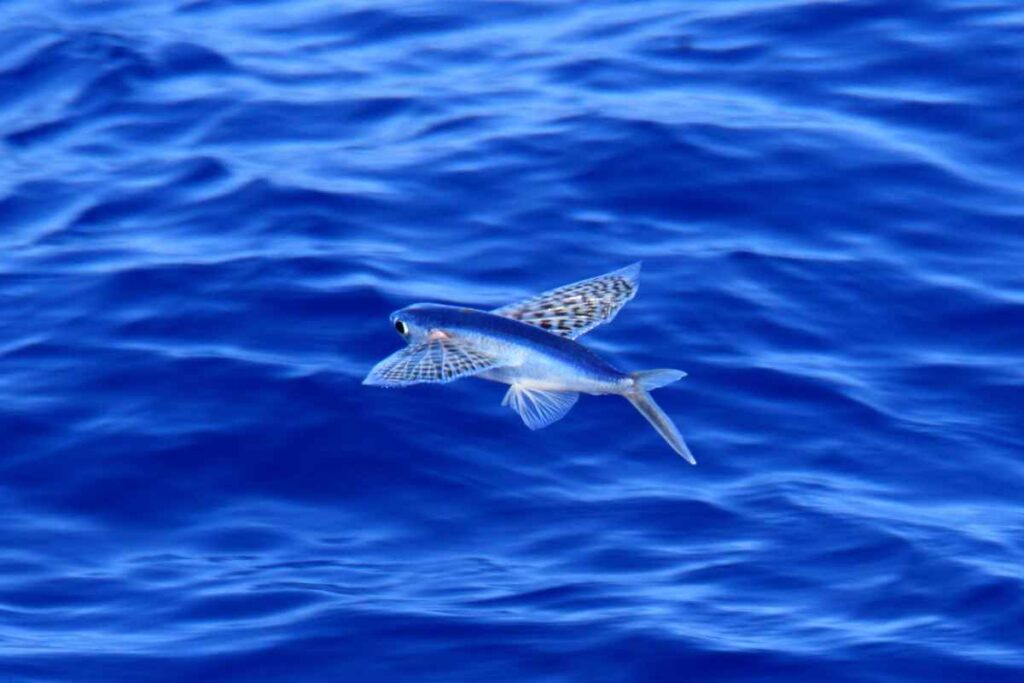Last Reviewed and Updated on March 2, 2023
Is it a bird? Is it a plane? It’s a flying fish! These fish are fascinating creatures known for their unique ability to glide through the air for impressive distances. Found in oceans around the world, flying fish have adapted well to life in the open waters. Explore some interesting facts about the flying fish, including their physical characteristics, behavior, and technological significance.

About Flying Fish
Flying fish, the Exocoetidae, are a fascinating group of fish that have evolved to be able to glide through the air for considerable distances, using their fins as “wings.”
About 64 different species of flying fish are found in warm and tropical waters worldwide. They most commonly inhabit the epipelagic zone, the top layer of the ocean, to depths of about 656 ft / 200 meters.
Flying fish mostly feed on plankton.
They have long, streamlined bodies and large, wing-like pectoral fins that they use to launch themselves into the air.
Most species of flying fish have stable populations, and their conservation status is listed as the least concern.
Interesting Facts About the Flying Fish
Dive in and learn some fun facts about the flying fish.

https://depositphotos.com/158929656/stock-photo-flying-fish-painting-with-water.html
Love learning about fish? Also, read our list of fun facts about fish.
Want to learn some random but impressive facts? Our list of 100 weird animal facts waits for you.
1. They can’t actually fly
Flying is the domain of birds and bats. No other animal is capable of true flying, and this is also the case when it comes to flying fish. They do, however, glide in the air.
In order to “fly,” this fish uses its powerful tail fin to propel itself to the surface of the water. Flying fish then begins to rapidly beat its tail fin to gain momentum, spread its enlarged fins, and lifts them out of the water.
2. Their glides are typically 160 ft / 50 m long but can be up to 1300 ft / 400 m long
Although they can’t fly, they can glide impressive distances. Some species glide for shorter distances, and some longer; the glides, on average, are about 160 ft / 50 m long.
There are reports of flying fish gliding close to 1300 ft / 400 meters.
The longest documented single flight lasted for 45 seconds, and it earned its place in the Guinness Book of World Records.
3. It is thought they “fly” to escape predators in the sea
When flying fish encounter a predator in the water, they use their powerful tail fin to launch themselves into the air and begin “flying.” This enables the fish to escape from underwater predators and potentially find new food sources or better habitats.
While this protects them from their underwater predators in the likes of swordfish, mackerel, tuna, and marlins, amongst others, this behavior does make them vulnerable to attacks by birds.
4. Some have two wing-like fins, and some have four
Not all flying fish are the same. Some evolved to only have a pair of wing-like fins, the two-winged flying fish in which only the pectoral fins are enlarged.
Then there are also the four-winged flying fish, where both their pectoral and pelvic fins have evolved to be wing-like.
5. The California flying fish is believed to be the largest flying fish species
The California flying fish may grow up to about 19 inches / 48 centimeters in length and is currently considered to be the largest member of the flying fish family.
6. These fish display countershading
Countershading is a form of camouflage most common in fish, other aquatic animals, and birds. It is also found in many species of mammals, reptiles, and insects. In countershading, the pattern of coloration on the animal’s body is different on the dorsal (upper) side, where it is darker than the ventral (lower) part.
This coloration is both a protective mechanism against predators and a cover for predators to get to their prey unnoticed, as it reduces the animal’s visibility from both above and below. When viewed from above, the darker coloration blends with the dark background, and when viewed from below, the lighter coloration blends with, the lighter surface of the water or with the sky.
7. When spawning, the sailing flying fish aggregate in groups with up to a million members
Some flying fish, like the sailing flying fish, spawn in great numbers, with groups sometimes reaching up to a million fish.
When spawning, these fish are very energetic, displaying jumping, gliding, and energetic swimming,
Several males pursue a single female, as the male-to-female ratio in these groups is three to one.
8. Larvae and juvenile fish can jump out of the water but can’t glide
Larvae have a different body shape than adults; they are more rounded, both in body shape and fins. This doesn’t stop them from attempting their fist jumps when they are as little as a week old.
Juveniles are able to jump out of the water but aren’t yet capable of gliding in the air yet either (study: Observations on the locomotion of post-larval and juvenile flying fish)
9. Flying fish were studied for airplane development from 1900 to the 1930s
During that time, flying fish were studied as models for early airplanes.
10. Barbados is known as “the land of the flying fish”
Flying fish is one of the national symbols of Barbados. It got this nickname because of the abundance of flying fish in the region.
11. Their name stems from the belief that they slept ashore
Exocoetidae is derived from the Latin word exocoetus, which is derived from the Ancient Greek word ἐξώκοιτος. The word translates to something like sleeping outside (ἔξω “outside” and κοῖτος “bed”). They got their name because it was believed flying fish jump out of the water to sleep ashore.
